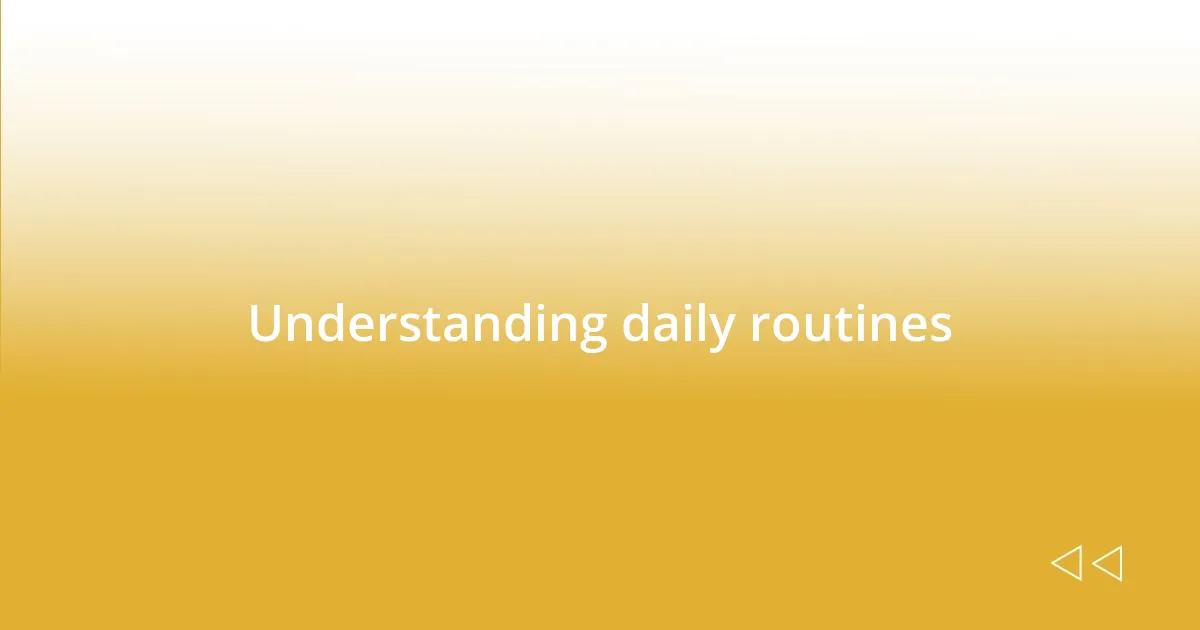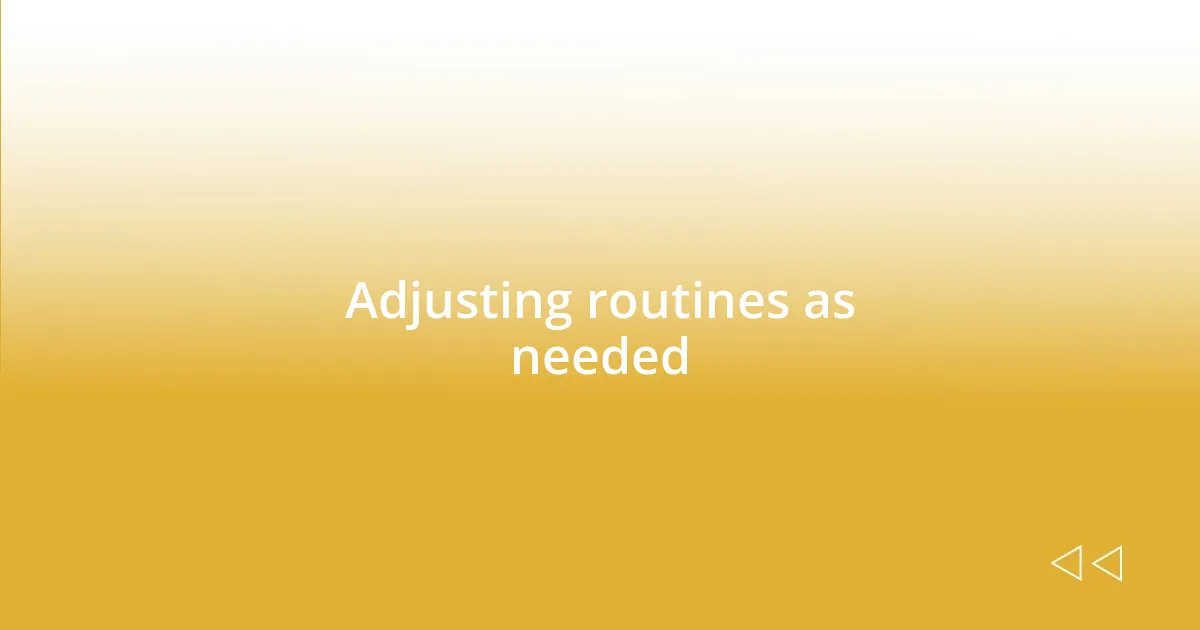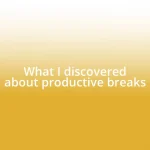Key takeaways:
- Small adjustments to daily routines can significantly enhance mental and physical well-being.
- Effective tool integration requires personalization, experimentation, and aligning tools with existing habits.
- Evaluating tool effectiveness involves assessing their impact on productivity and ensuring they add value rather than clutter.
- Flexibility in routines, such as adjusting tasks based on mood, can increase efficiency and prevent burnout.

Understanding daily routines
Daily routines form the backbone of our lives, often providing structure and predictability that can be comforting. I remember a particularly hectic week when I noticed my productivity plummeting. It was only when I stepped back and examined my routine that I realized how much I had strayed from my usual patterns, which brought me to question: Are we really aware of how our daily habits shape our mental and physical well-being?
I’ve found that small tweaks in my routine, like adding a morning walk or dedicating specific time blocks for work and relaxation, can create a significant impact. For example, simply switching my coffee ritual to a quiet moment outside in the sun transformed those first hours of the day into something I truly looked forward to. Have you ever had a small change in your routine lead to a surprisingly uplifting shift in your mood?
It’s fascinating how our routines can be both liberating and constraining. I recall grappling with the constraints of my own rigid schedule, which left me feeling like I was moving through life on autopilot. The moment I introduced more flexibility—allowing for spontaneous activities or downtime—was an eye-opener. I realized that understanding and refining my routines wasn’t just about time management; it was about enhancing my quality of life.

Identifying useful tools
Identifying useful tools begins with recognizing what we truly need in our daily lives. I remember my relentless search for an app to streamline my to-do list, only to realize that the simplest tool—a notepad—was what I enjoyed most. Sometimes, it’s about finding solutions that resonate personally rather than seeking the trendiest, most sophisticated options.
As I explored various tools, I discovered that their usefulness often lies in how well they integrate with my existing routines. Take digital calendars, for example. At first, I found them overwhelming, but once I personalized mine with color codes for different aspects of my life, it became an indispensable resource. Have you ever noticed how a simple adjustment can turn something complicated into a seamless part of your day?
Ultimately, identifying useful tools is about experimentation and adaptation. I often assess new tools against my current habits, asking myself: Does this enhance my productivity or add unnecessary chaos? I had a phase where I used multiple project management apps, which ended up complicating rather than clarifying my tasks. The moment I consolidated everything into one platform, suddenly, clarity emerged amidst the chaos.
| Tool | Personal Experience |
|---|---|
| Notepad | Simple and enjoyable; connects directly with my ideas. |
| Digital Calendar | Overwhelming at first, but color-coded organization improved usage. |
| Project Management Apps | Too many options led to chaos; consolidating was key. |

Selecting tools for efficiency
Selecting tools for efficiency requires a thoughtful approach to ensure they truly enhance your daily routine. I often find myself evaluating how each tool aligns with my goals. Recently, I experimented with a time-tracking app, initially skeptical about its value. Much to my surprise, it revealed how much time I spent on minor tasks, which prompted me to allocate time more wisely. Have you ever had a tool reveal patterns you’d never noticed before?
When it comes down to choosing the right tools, here are some key factors I consider:
- Compatibility: Does this tool integrate seamlessly with what I already use?
- User Experience: Is it intuitive and easy to interact with?
- Purpose: Will it genuinely serve my productivity goals, or is it just adding noise to my day?
- Feedback Loop: Am I able to track my progress and refine how I use this tool over time?
- Enjoyment: Do I actually enjoy using this tool, or does it feel like a chore?
By keeping these criteria in mind, I ensure that each tool I select enhances my efficiency rather than complicates my routine, ultimately leading to a more productive day.

Integrating tools into tasks
Integrating tools into tasks often requires a willingness to adjust and experiment. I vividly recall the excitement of trying out new productivity apps, only to find myself frustrated when they didn’t align with my workflow. One day, I stumbled upon a simple checklist app that allowed me to check off tasks with a satisfying click. The relief I felt was undeniable. Have you ever experienced that joy when a tool finally clicks into place in your routine?
I’ve learned that integrating tools effectively involves identifying patterns in how I work. For instance, when I started using a note-taking app during meetings, I didn’t realize how crucial it would become. By linking my notes directly to my calendar invites, I started to see my productivity soar. It made me wonder: how often do we overlook the synergy between tools we already have? Sometimes, it’s those connections that truly elevate our efficiency.
Moreover, I firmly believe that integration is a two-way street. Tools should adapt to our needs just as much as we adapt to them. When I began using voice-to-text software for jotting down ideas on the go, I was amazed at how it transformed my brainstorming sessions. Instead of pausing to type, I could let my thoughts flow freely. What tools have you tried that helped you tap into your creativity like that? Finding the right fit can truly make tasks feel less like chores and more like enjoyable activities.

Evaluating tool effectiveness
Evaluating tool effectiveness is vital to ensuring that I’m not just adding clutter to my day. I often find myself reflecting on how a particular tool impacts my workflow. For instance, I used to use a project management tool that seemed promising but ended up being more of a hassle. After a month, I realized it didn’t fit my needs and switched to a simpler, more straightforward option. Have you ever held onto a tool, believing it would eventually “work out,” only to find it dragging you down instead?
Another consideration is how well I can measure the differences a tool makes. I once integrated a habit-tracking app into my routine with skepticism. However, when I reviewed my progress at the end of the month, I felt a surge of motivation seeing the visual representation of my efforts. That experience reinforced my belief that tools should not only assist us; they should clearly demonstrate their value. How do you gauge the success of the tools you use—by feeling, numbers, or something else?
Ultimately, it’s about specificity. I’ve learned to ask targeted questions when evaluating any tool’s effectiveness. Is this tool saving me time or simply shifting my focus elsewhere? Recently, I incorporated a focus timer into my routine and immediately noticed that my concentration improved. The burst of productivity felt exhilarating. It makes me wonder: are the tools I use truly working as intended, or are they just another beautiful distraction? Identifying that distinction can lead to a more tailored and effective daily routine.

Adjusting routines as needed
Adjusting my routines as needed is something I’ve come to embrace wholeheartedly. I remember a particularly hectic week where my usual morning routine started feeling like a burden. The moment I realized this, I decided to swap my early-morning yoga session for a brisk walk outside. That shift not only revitalized my energy but also gave my mind a refreshing reset. Have you ever felt that surge of clarity when you change just one small part of your day?
I often find myself tweaking my approach to tasks based on how I’m feeling. For example, there are days when writing feels like pulling teeth, so instead of pushing through, I switch to brainstorming with a mind map. This simple adjustment invites creativity back into the process, and suddenly, I’m jotting down ideas like a fountain. It’s fascinating how a slight change can breathe new life into a routine. What’s one small tweak you’ve made that had a big impact?
Reflecting on my weekly habits has revealed how essential flexibility is. Just recently, I adjusted my scheduling tool to block out time for breaks instead of continuously grinding away at tasks. At first, it felt counterintuitive, but I quickly noticed my efficiency skyrocketing. Those breaks became my secret weapon against burnout! Isn’t it amazing how allowing ourselves to step back can actually propel us forward? Embracing these adjustments makes a noticeable difference in my day-to-day experiences.

Maintaining consistency with tools
Maintaining consistency with the tools I use is crucial for optimizing my daily routines. I remember when I first started using a digital calendar; keeping up with it felt overwhelming at first. However, once I committed to checking it every morning with my coffee, it became a pivotal part of my day. Do you have a tool that you struggled to integrate until you forged a habit around it?
There are moments when I find myself slipping and abandoning certain tools, especially during hectic times. I had this habit-tracking journal that helped me stay accountable, but when life got busy, I let it fall to the wayside. After recognizing that my commitment waned whenever I was stressed, I started pairing it with my evening wind-down routine. I now reflect on my day while sipping tea, and it feels less like a task and more like a comforting closure. What small shifts have you made to keep your tools on track?
I’ve learned that setting reminders or notifications can be a game-changer for maintaining consistency. I’ll set a gentle nudge on my phone to prompt me to check in with my productivity app, creating that mental trigger for usage. This little trick has transformed my engagement levels from sporadic to reliable. Have you ever tried a simple reminder that turned an obligation into a habit? Our tools can serve us best when we weave them seamlessly into the fabric of our routines.















